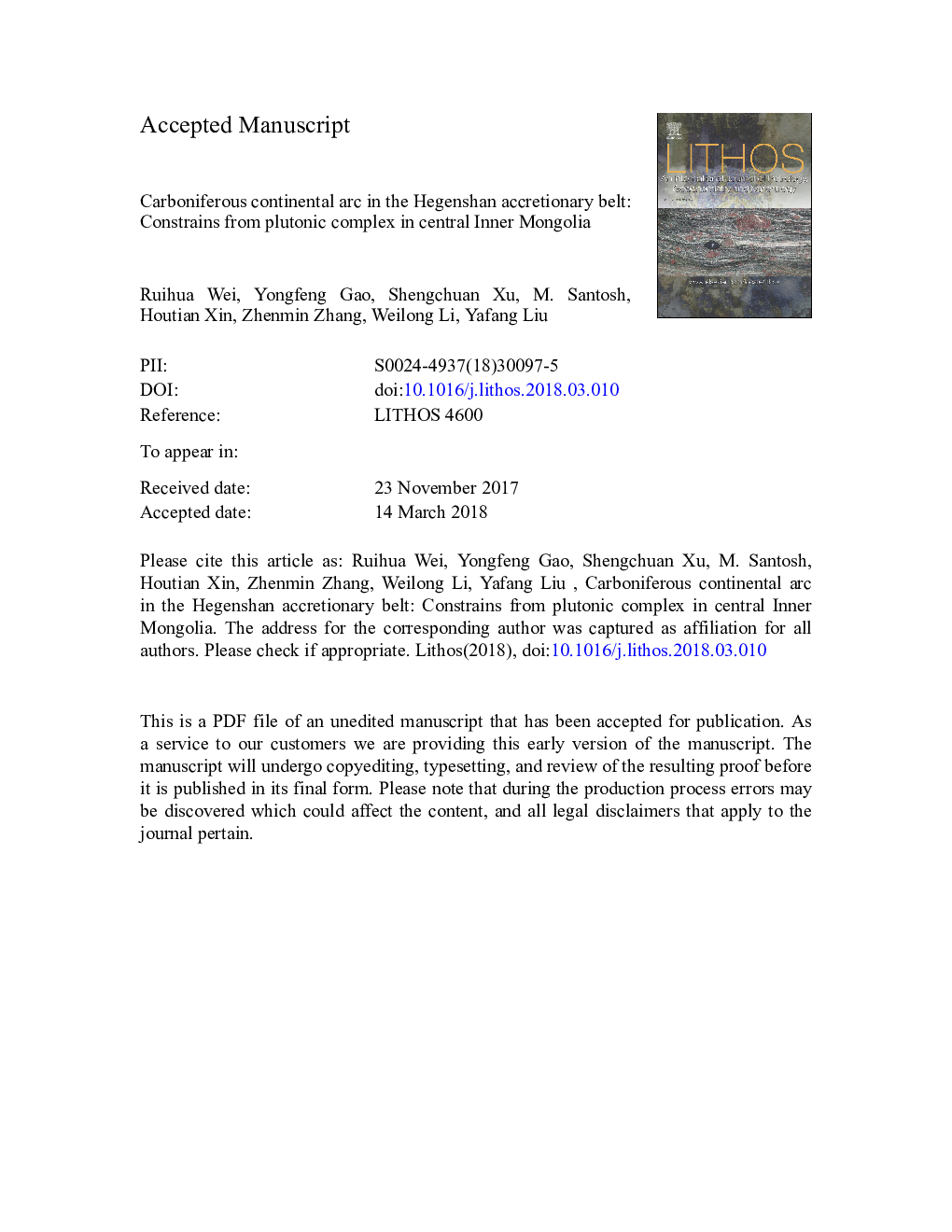| کد مقاله | کد نشریه | سال انتشار | مقاله انگلیسی | نسخه تمام متن |
|---|---|---|---|---|
| 8911648 | 1638620 | 2018 | 61 صفحه PDF | دانلود رایگان |
عنوان انگلیسی مقاله ISI
Carboniferous continental arc in the Hegenshan accretionary belt: Constrains from plutonic complex in central Inner Mongolia
ترجمه فارسی عنوان
قوس قاره ای کربنیک در کمربندهای هگنشان: محدودیت هایی از مجموعه پلوتونیک در مغولستان مرکزی
دانلود مقاله + سفارش ترجمه
دانلود مقاله ISI انگلیسی
رایگان برای ایرانیان
کلمات کلیدی
موضوعات مرتبط
مهندسی و علوم پایه
علوم زمین و سیارات
ژئوشیمی و پترولوژی
چکیده انگلیسی
The architecture and tectonic evolution of the Hegenshan accretionary belt in the Central Asian Orogenic Belt (CAOB) remains debated. Here we present an integrated study of zircon U-Pb isotopic ages, whole rock major-trace elements, and Sr-Nd-Pb isotopic data from the Hegenshan volcanic-plutonic belt in central Inner Mongolia. Field observations and zircon U-Pb ages allow us to divide the intrusive complex into an early phase at 329-306â¯Ma and a late phase at 304 to 299â¯Ma. The intrusive bodies belong to two magma series: calc-alkaline rocks with I-type affinity and A-type granites. The early intrusions are composed of granodiorite, monzogranite and porphyritic granite, and the late calc-alkaline intrusions include gabbro though diorite to granodiorite. The calc-alkaline intrusive rocks exhibit a well-defined compositional trend from gabbro to granite, reflecting continuous fractional crystallization. These rocks show obvious enrichment in LILEs and LREEs and relative depletion of HFSEs, typical of subduction-related magma. They also exhibit isotopic characteristics of mantle-derived magmas such as low initial 87Sr/86Sr (0.7029-0.7053), positive ÉNd(t) values (0.06-4.76) and low radiogenic Pb isotopic compositions ((206Pb/204Pb)Iâ¯=â¯17.907-19.198, (207Pb/204Pb)Iâ¯=â¯15.474-15.555, (208Pb/204Pb)Iâ¯=â¯37.408-38.893). The marked consistency in geochemical and isotopic compositions between the intrusive rocks and the coeval Baoligaomiao volcanic rocks define a Carboniferous continental arc. Together with available regional data, we infer that this east-west trending continental arc was generated by northward subduction of the Hegenshan ocean during Carboniferous. The late alkali-feldspar granites and the high-Si rhyolites of the Baoligaomiao volcanic succession show similar geochemical compositions with high SiO2 and variable total alkali contents, and low TiO2, MgO and CaO. These rocks are characterized by unusually low Sr and Ba, and high abundances of Zr, Th, Nb, HREEs and Y, comparable to the features of typical A2-type granites including their high ratios of FeOT/MgO, Ga/Al and Y/Nb. Our study suggests that the A-type granite was derived from a distinct magma source rather than through fractional crystallization of the coeval calc-alkaline magmas. Their Nd-Pb isotopic compositions are similar to those of calc-alkaline arc rocks and are compatible with partial melting of pre-existing juvenile basaltic crust in the continental arc. Notably, the widespread eruptions of A2-type rhyolitic magmas (305.3â¯Ma-303.4â¯Ma) following a short period of magmatic quiescence was temporally and spatially associated with bimodal magmatism with mantle-derived gabbro-diorites and A-type granites (304.3â¯Ma-299.03â¯Ma) in the pre-existing arc volcanic-plutonic belt (329â¯Ma-306â¯Ma). Such a marked change in the magma affinity likely indicates subducted slab break-off resulting in a change of the regional stress field to an extensional setting within the Carboniferous continental arc that runs E-W for few thousands of kilometers. Thus, the onset of the late magmatism (305-299â¯Ma) likely represents the maximum age for the cessation of the northward subduction in the Hegenshan ophiolite-arc-accretion belt.
ناشر
Database: Elsevier - ScienceDirect (ساینس دایرکت)
Journal: Lithos - Volumes 308â309, May 2018, Pages 242-261
Journal: Lithos - Volumes 308â309, May 2018, Pages 242-261
نویسندگان
Ruihua Wei, Yongfeng Gao, Shengchuan Xu, M. Santosh, Houtian Xin, Zhenmin Zhang, Weilong Li, Yafang Liu,
